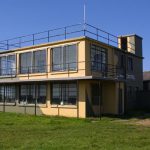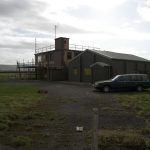- Jurby Airfield Control Tower
- Jurby Airfield Control Tower
- Aurora Mulligan TT
Royal Air Force Station Jurby (or RAF Jurby) was a former Royal Air Force station built in the north west of the Isle of Man. It was opened in 1939 on 400 acres of land acquired by the Air Ministry in 1937. During World War II the station was used for training as an Armament Training Station, Air Observer School, Bombing & Gunnery School, and the Air Navigation & Bombing School, in addition to a variety of operational squadrons.
Jurby was originally a grass airfield but was later equipped with hard runways. Operationally it helped protect Belfast and Liverpool from German air raids. RAF Jurby closed in 1963.
The airfield is in part still usable. Many of the airfield buildings on the northern side of the Ballamenagh Road were demolished in the mid to late 2000's and only the road and path layouts exist alongside foundations.
Many of the original hangars can still be seen on the south side of the Ballamenagh Road though have been re-clad with more modern materials. This area received a £2m government injection to fund a new main entrance with resurfaced roads in 2008 and is known as the Jurby Industrial Estate.
Other buildings including the Control Tower and the increasingly rare timber buildings survive in various states of disrepair, some of which date back to 1939.
The Manx Transport Museum which opened in Jurby in 2009.
A large hangar, built originally to manufacture an airship, was removed and the base of the building is now home to a go-kart track.
The Isle of Man prison was re-located to Jurby Airfield in 2008. The prison is built within the airfield site with the entrance road cutting through the otherwise untouched western taxiway.
The airfield had been used for an annual airshows until 2004. Since its inaugural event in 2009, the airfield has been home home to the annual Jurby Festival of Speed which takes place on the middle Sunday of the Islands Classic TT (formerly Grand Prix) fortnight. Although not an airshow, the 2012 festival received a flypast from a Spitfire and a C-47 Dakota in 2013. The main events of the day are a bike rally and friendly races around the "course" which takes in sections of the runway, taxiway and perimeter track. Attendance to the site has reached 10,000 people. Motor Sports are able to make use of the airfield course all year round.
Another of the re-clad Bellman hangars has been home to the free-entry Jurby Transport Museum since 2010. The museum is home to many buses and trams that have formed part of the islands public transport network for many years. In keeping with their aviation surroundings, there are the airship parts mentioned above, a spitfire replica and a glider kept in pieces in the back storage yard.
There is a business located on the airfield since 1972. Jurby Junk was set up in 1972 in the old armoury on the airfield site. The business was later moved into two purpose built warehouse units with one half dedicated to books. The business has been since inception by Stella Pixton who is the daughter of Howard Pixton - the first British winner of the Schneider Trophy Air race in 1914.



